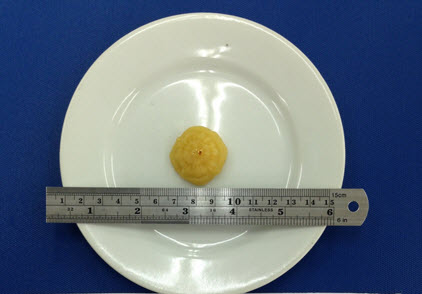การพัฒนาขนมไทยเพื่อสุขภาพ : กรณีศึกษาขนมทองเอก
Main Article Content
Abstract
Sirimon Chaikate, Pornpen Morakotjinda and Weena Thongrod
รับบทความ: 28 ตุลาคม 2559; ยอมรับตีพิมพ์: 14 สิงหาคม 2560
บทคัดย่อ
การศึกษาครั้งนี้มีวัตถุประสงค์เพื่อ (1) พัฒนาผลิตภัณฑ์ขนมทองเอกเพื่อสุขภาพ โดยการปรับลดไขมัน ปริมาณน้ำตาล และเสริมธัญพืชในผลิตภัณฑ์ขนมทองเอก (2) เพื่อศึกษาการยอมรับของผู้บริโภคที่มีต่อขนมทองเอกเพื่อสุขภาพ และ (3) ศึกษาคุณค่าทางโภชนาการของขนมทองเอกเพื่อสุขภาพโดยการวิเคราะห์ทางเคมีอาหาร ผลการเปรียบเทียบขนมทองเอก 3 สูตรพื้นฐานโดยการยอมรับทางประสาทสัมผัส (9-point hedonic scale) ในด้านลักษณะปรากฏ สี รสชาติ กลิ่น เนื้อสัมผัส และความชอบโดยรวม พบว่า คะแนนการยอมรับทางประสาทสัมผัสสูตรที่ 1 มากกว่าสูตรที่ 2 และสูตรที่ 3 (p < 0.05) ผู้วิจัยเลือกสูตรที่ 1 มาพัฒนาโดยการทดแทนกะทิด้วยกะทิธัญพืช พบว่า สูตรที่ทดแทนด้วยกะทิธัญพืช มีคะแนนการยอมรับทางประสาทสัมผัสมากกว่าสูตรพื้นฐาน (p < 0.05) จากนั้นเลือกสูตรที่ทดแทนด้วยกะทิธัญพืชมาพัฒนาโดยการทดแทนไข่แดงจากไข่ไก่ด้วยถั่วเขียวเลาะเปลือกร้อยละ 50 และร้อยละ 100 พบว่า สูตรที่ทดแทนไข่แดงจากไข่ไก่ด้วยถั่วเขียวเลาะเปลือกร้อยละ 100 มีคะแนนการยอมรับทางประสาทสัมผัสมากกว่าสูตรพื้นฐานและสูตรที่ทดแทนไข่แดงจากไข่ไก่ด้วยถั่วเขียวเลาะเปลือกร้อยละ 50 (p < 0.05) ผู้วิจัยจึงเลือกสูตรที่ทดแทนไข่แดงจากไข่ไก่ด้วยถั่วเขียวเลาะเปลือก ร้อยละ 100 มาพัฒนาโดยการลดปริมาณน้ำตาลลงร้อยละ 30 35 และ 40 ตามลำดับ พบว่า สูตรที่ลดปริมาณน้ำตาลลงร้อยละ 35 มีคะแนนการยอมรับทางประสาทสัมผัสมากกว่าสูตรพื้นฐานและสูตรที่ลดปริมาณน้ำตาลลงร้อยละ 30 และ 40 (p < 0.05) ดังนั้นจึงเลือกสูตรที่ลดปริมาณน้ำตาลลงร้อยละ 35 มาวิเคราะห์คุณค่าทางโภชนาการโดยการวิเคราะห์ทางเคมีอาหาร ผลการศึกษาพบว่า สูตรที่ลดปริมาณน้ำตาลลงร้อยละ 35 มีพลังงานรวม ปริมาณของคาร์โบไฮเดรต โปรตีน ไขมัน และน้ำตาล น้อยกว่าสูตรพื้นฐาน
คำสำคัญ: ขนมไทยเพื่อสุขภาพ ทองเอก การยอมรับ
Abstract
The objectives of this research were (1) to develop healthy Thong Ake by reducing fat, sugar and supplemented cereal in Thong Ake, (2) to study consumer acceptance on healthy Thong Ake, and (3) to determine nutritive values of healthy Thong Ake by chemical analysis. Three standard formulations of Thong Ake were investigated by using sensory evaluation (9-point hedonic scale) in terms of appearance, color, taste, odor, texture and overall acceptability. The results showed that there was a difference in sensory preference scores (p < 0.05). The first formula was developed by substituted cereal cream instead of coconut milk. The results showed that Thong Ake with cereal cream formula was a difference in sensory preference scores (p < 0.05), compared to coconut milk formula. In addition, Thong Ake with cereal cream formula was developed by substitution with 50% and 100% mung bean instead of egg yolk. The result was found that 100% mung bean replacement formula was a difference in sensory preference scores (p < 0.05) from the others. After that, Thong Ake with cereal cream and 100% mung bean replacement was reduced amount of sugar by 30%, 35%, and 40%. The result was found that 35% decreasing sugar formula was a difference in sensory preference scores (p < 0.05) from the others. The chemical analysis of Thong Ake with cereal cream, 100% mung bean replacement and 35% sugar reducing formula was lower than standard formula, in terms of total energy, amount of carbohydrate, protein, fat and sugar.
Keywords: Healthy Thai desserts, Thong Ake, Acceptance
Downloads
Article Details

This work is licensed under a Creative Commons Attribution-NonCommercial 4.0 International License.
References
Anprong, P. (2008). Principles of Sensory Food Analysis. 2nd Edition. Bangkok: Chulalongkorn University. (in Thai)
Green Mung Beans. (n.p.). Retrieved from https://www.greenmungbeans.com/health-benefits, October 27, 2016.
Khongphan, S., and Suwanphong, M. (1988). Snacks and Juice. 5th edition. Bangkok: Sangdad. Page 20. (in Thai)
Kuamornphatana, N. (2010). The Ways of Thai Deserts. Bangkok: Phimdee. (in Thai)
Loetlakkhanawong, P. (2005). Egg Consumption. Retrieved from http://nutrition.anamai.moph.go.th/temp/main/view.php?group=1&id=599, October 27, 2016. (in Thai)
Mongkolvanich, C., and Chattiwong, R. (2014). Youth opinions of the image of Thai dessert in Thailand. Cultural Approach 15(27): 39–50.
Prasiri, S. (2012). Thai Desert. Bangkok: M.I.S. (in Thai)
Saleephan, S., Kongsuwan, T., and Ungkanavin, N. (2015). How Much Eating Fat Don’t Get Illness. Retrieved from http://nutrition. anamai.moph.go.th/temp/files/ภาพพลิกกินมันแค่ไหนไม่ป่วย.pdf, August 6, 2015. (in Thai)
Sirichakwal, P. (2006). Why is 6 Teaspoons of Sugar? Retrieved from http://nutrition.anamai.moph.go.th/temp/main/view.php?group=3&id=71, August 5, 2015. (in Thai)
Sirichakwal, P., and Suthutvoravut, U. (2012). Food-based Dietary Guideline Review and Analysis. Bangkok: The War Veterans Organization of Thailand under Royal Patronage of His Majesty Printing House. (in Thai)
Sirikulchayanonta, C., and Ungchusak, C. (2012). Sugar Health and Management for Appropriate Consumption. Bangkok: The War Veterans Organization of Thailand under Royal Patronage of His Majesty Printing House. (in Thai)
Spence, J. D. (2016). Dietary cholesterol and egg yolk should be avoided by patients at risk of vascular disease. Journal of Transnational Internal Medicine 4(1): 20–24.
Thai Health Promotion Foundation. (2014). Dek Thai Mai Kin Whan’s project. Retrieved from http://www.hfocus.org/print/ content/2014/01/6153, June 11, 2016. (in Thai)
Thongkham, M. (2012). Royal Thai Desert Recipes. Bangkok: Suesukapab. (in Thai)
Ungchusak, C. (2012). Sugar Health and Management for Appropriate Consumption. Bangkok: The War Veterans Organization of Thailand under Royal Patronage of His Majesty Printing House. (in Thai)
USDA. (2016). Basic Report 11043, Mung Beans, Mature Seeds, Sprouted, Raw. Retrieved from http://www.ndb.nal.usda.gov/ndb/foods/ show/2846, July 10, 2017.
Yang, Q., Zhang, Z., Gregg, E. W., Flanders, W. D., Merritt, R., and Hu, F. B. (2014). Added sugar intake and cardiovascular disease mortality among US adults. JAMA Internal Medicine 174(4): 516–524.
